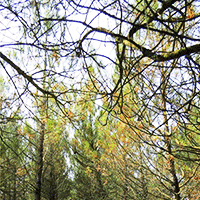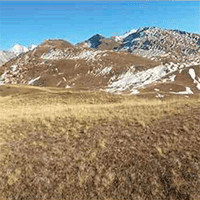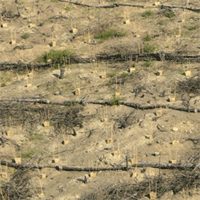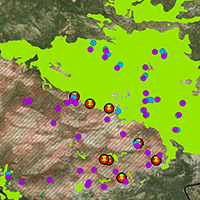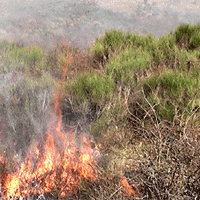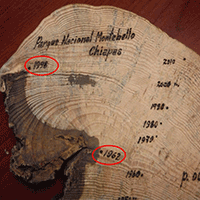
Historical fire ecology and its effect on vegetation dynamics of the Lagunas de Montebello National Park, Chiapas, México
Laura Patricia Ponce-Calderón (1) , Dante Arturo Rodríguez-Trejo (2), José Villanueva-Díaz (3), Bibiana Alejandra Bilbao (4), Guadalupe Del Carmen Álvarez-Gordillo (1), Gabriela Vera-Cortés (1)
iForest - Biogeosciences and Forestry, Volume 14, Issue 6, Pages 548-559 (2021)
doi: https://doi.org/10.3832/ifor3682-014
Published: Dec 01, 2021 - Copyright © 2021 SISEF
Research Articles
Abstract
Historical information on wildfires and dendrochronological studies offer meaningful clues about fire and climate regimes, factors that affect forest structure and dynamics. This study aimed to determine the effect of fire history on vegetation dynamics and successional pathways of areas under different fire management policies in the Lagunas de Montebello National Park (LMNP), Chiapas, México. The selected study sites were El Parque area under fire exclusion policies since 1961; Tziscao-inhabited area under fire prohibition since 1984; and Antelá area with a traditional agricultural fire management history. A Pinus oocarpa ring-width chronology was used as a proxy for climate variability to which wildfire occurrence was mapped and to determine the establishment patterns of this dominant species. Current vegetation composition and structure and fuel loads were determined to characterise the study sites. Large wildfires, like those occurring in 1984 and 1998, were associated with periods of high humidity followed by intense droughts; they were linked to strong El Niño events and severely impacted the LMNP. Vegetation dynamics indicated simplification of mesophyll forest (climax) to pine-oak-sweetgum forests, with Pinus dominating the overstorey in all sampling sites. Pine, oak and sweetgum species were the dominant juvenile trees in Antelá, El Parque and Tziscao, respectively. Late-successional seedlings (i.e., Prunus) were present in Antelá and El Parque, while were absent from Tziscao where several wildfires had occurred. Fuel accumulation in sites within protected areas subject to fire exclusion policies was very high (40-68 t ha-1); in contrast, it was the lowest in rural Antelá (24 t ha-1). Considering vegetation vulnerability to wildfires associated with extreme humid-dry climate events, increased fire hazard due to fuel accumulation, and the socio-ecological impacts of these events, we recommend revising the fire exclusion policies currently implemented in the LMNP and applying an integrated fire management approach that incorporates local socio-ecological conditions.
Keywords
Historical Ecology, Dendrochronology, Fire Ecology, Ecological Succession, Fuel Loads
Authors’ Info
Authors’ address
Guadalupe Del Carmen Álvarez-Gordillo 0000-0002-9543-7920
Gabriela Vera-Cortés 0000-0003-0845-7673
El Colegio de la Frontera Sur, Departamento de Sociedad y Cultura (México)
División de Ciencias Forestales, Universidad Autónoma Chapingo. Estado de México (México)
Laboratorio de Dendrocronología, INIFAP CENID-RASPA, Gómez Palacio, Durango (México)
Departamento de Estudios Ambientales, Universidad Simón Bolívar, Caracas (Venezuela)
Corresponding author
Paper Info
Citation
Ponce-Calderón LP, Rodríguez-Trejo DA, Villanueva-Díaz J, Bilbao BA, Álvarez-Gordillo GDC, Vera-Cortés G (2021). Historical fire ecology and its effect on vegetation dynamics of the Lagunas de Montebello National Park, Chiapas, México. iForest 14: 548-559. - doi: 10.3832/ifor3682-014
Academic Editor
Davide Ascoli
Paper history
Received: Oct 21, 2020
Accepted: Oct 06, 2021
First online: Dec 01, 2021
Publication Date: Dec 31, 2021
Publication Time: 1.87 months
Copyright Information
© SISEF - The Italian Society of Silviculture and Forest Ecology 2021
Open Access
This article is distributed under the terms of the Creative Commons Attribution-Non Commercial 4.0 International (https://creativecommons.org/licenses/by-nc/4.0/), which permits unrestricted use, distribution, and reproduction in any medium, provided you give appropriate credit to the original author(s) and the source, provide a link to the Creative Commons license, and indicate if changes were made.
Web Metrics
Breakdown by View Type
Article Usage
Total Article Views: 35928
(from publication date up to now)
Breakdown by View Type
HTML Page Views: 29055
Abstract Page Views: 4086
PDF Downloads: 2238
Citation/Reference Downloads: 4
XML Downloads: 545
Web Metrics
Days since publication: 1458
Overall contacts: 35928
Avg. contacts per week: 172.49
Citation Metrics
Article Citations
Article citations are based on data periodically collected from the Clarivate Web of Science web site
(last update: Mar 2025)
Total number of cites (since 2021): 7
Average cites per year: 1.40
Publication Metrics
by Dimensions ©
Articles citing this article
List of the papers citing this article based on CrossRef Cited-by.
References
A simple pith locator for use with off-center increment cores. Journal of Forestry 56: 141.
Gscholar
21st Century drought- related fires counteract the decline of Amazon deforestation carbon emissions. Nature Communications 9: 536.
CrossRef | Gscholar
Impactos de los incendios de 1998 en el bosque mesófilo de montaña en Los Chimalapas, Oaxaca [Impact of the 1998 wildfires in the mountain mesophyll forest in Los Chimalapas, Oaxaca]. In: “Incendios Forestales en México. Métodos de Evaluación” (Villers RL, López BJ eds) UNAM, México, DF, pp. 125-146 [in Spanish]
Online | Gscholar
The role of fire on vegetation dynamics of upland savannas of the Venezuelan Guayana. In: “Tropical Fire Ecology: Climate Change, Land Use and Ecosystem Dynamics” (Cochrane MA ed). Springer-Praxis, Heidelberg, Germany, pp. 451-480.
CrossRef | Gscholar
Wildfires. In: “Adaptation to Climate Change Risks in Ibero-American Countries RIOCCADAPT Report” (Moreno JM, Laguna-Defior C, Barros V, Calvo Buendía E, Marengo JA, Oswald Spring U eds). McGraw Hill, Madrid, Spain, pp. 435-496.
Online | Gscholar
Efecto de incendios en la vegetación de sotobosque y propiedades químicas de suelo de bosques templados [Effect of forest fires on the forest understory and soil chemical properties of temperate forests]. Agro productividad 13 (4): 65-72. [in Spanish]
CrossRef | Gscholar
Régimen histórico de incendios y su relación con el clima en un bosque de Pinus hartwegii al norte del estado de Puebla, México [Historic fire regime and its relationship with climate in a Pinus hartwegii forest in northern Puebla state, Mexico]. Bosque 37 (2): 389-399. [in Spanish]
CrossRef | Gscholar
Program ARSTAN and user’s manual. Laboratory of Tree-Ring Research, University of Arizona, Tucson, USA, pp. 15.
Gscholar
Modificaciones al sistema de clasificación climática de Köppen [Modifications to the Köppen climatic classification system]. Instituto de Geografía, Universidad Nacional Autónoma de México, México, pp. 97. [in Spanish]
Gscholar
Monitoreo de efectos ecológicos del fuego y quemas prescritas: vacíos en el manejo forestal y de áreas naturales protegidas en Guatemala, Centroamérica [Monotoring the ecological effects of fire and prescribed burns: vacuums in the forest management and the natural protected areas in Guatemala, Central America]. In: Memorias de “Ecología y Biodiversidad. V Conferencia Internacional Sobre Incendios Forestales”. Sevilla (Spain) 13-17 May 2007, pp. 12. [in Spanish]
Online | Gscholar
Restauración de bosques en América Latina [Restoration of forests in Latin America]. Fundación Internacional para la Restauración de Ecosistemas (FIRE) and Mundi-Prensa, México, pp. 252. [in Spanish]
Gscholar
Carta de efectos climáticos regionales [Map of regional climatic effects]. Mayo-octubre y noviembre-abril. Las Margaritas, Aguascalientes, Mexico, scale 1:250.000, E15-12-D15-3. [In Spanish]
Gscholar
Climate change 2012: impacts, adaptation and vulnerability. Intergovernmental Panel of Climatic Change - IPCC, Cambridge University Press, Cambridge, UK, pp. 1042.
Gscholar
Efecto de los incendios forestales en la regeneración natural de Pinus oocarpa var. ochoterenae Martínez [Effect of forest fires in the natural regeneration of Pinus oocarpa var. ochoterenae Martínez]. Revista Chapingo, Serie Ciencias Forestales y del Ambiente 9 (2): 125-130. [in Spanish]
Online | Gscholar
Best practices of fire use - Prescribed burning and suppression fire programmes in selected case-study regions in Europe. Report no. 24, European Forest Institute Research - EFI, Joensuu, Finland, pp. 182.
Gscholar
Living with fire - Maintaining ecosystems and livelihood with the integral fire management. The Nature Conservancy, Global Fire Initiative, Washington, DC, USA, pp. 28.
Gscholar
Modelación de la probabilidad de mortalidad de Pinus oocarpa en áreas de quema pres-crita o incendiadas en Chiapas [Modeling the probability of mortality of Pinus oocarpa in prescribed burn or wildfire áreas in Chiapas]. Acta Universitaria 28: 1-9. [in Spanish]
CrossRef | Gscholar
Experiencias en quemas controladas, quemas prescritas e incendios forestales en finca forestal nacional de San Jerónimo, Baja Verapaz [Experiences in controlled burns, prescribed burns and forest fires in the national forest farm of San Jerónimo, Baja Verapaz]. Curso básico en planificación de quemas prescritas. San Jerónimo, Baja Verapaz, Guatemala, Instituto Nacional de Bosques, Sistema nacional de prevención y control de incendios forestales, Asociación Vivamos Mejor, The Nature Conservancy, pp. 14. [in Spanish]
Gscholar
Educación e incendios forestales [Education and forest fires]. Mundi Prensa, UACH, México, pp. 201. [in Spanish]
Gscholar
Incendios de vegetación: su ecología, manejo e historia [Wildfires: its ecology, manegement and history]. Vol. 1, Ed. Colegio de Postgraduados, Universidad Autónoma Chapingo, Semarnat, México, pp. 887. [in Spanish]
Gscholar
Efectos del fuego en el arbolado de un bosque tropical de pino y en el de una selva baja caducifolia en Villaflores, Chiapas [Fire effects on the trees of a tropical pine forest and of a dry tropical forest in Villaflores, Chiapas]. Ciencia Florestal 29 (3): 1033-1047. [in Spanish]
CrossRef | Gscholar
Instructivo de quemas prescritas para el manejo integral del fuego en el municipio de Villaflores y la Reserva de la Biosfera La Sepultura, Chiapas, México [Guide of prescribed burns for the integral fire management at the Villaflores municipality and the La Sepultura biosphere reserve, Chiapas, Mexico]. FMCN, USDA Forest Service, US AID, Biomasa AC, UACH, Mpio, Villaflores, Gob. Edo. Chis., ANCF, SEMARNAT, CONANP, CONAFOR, México, pp. 183. [In Spanish]
Gscholar
Vegetación de México [Vegetation of Mexico] (1st edn). Comisión Nacional para el Conocimiento y Uso de la Biodiversidad, México DF, pp. 504. [in Spanish]
Gscholar
Fire on earth. An introduction. Wiley Blackwell, Singapore, pp. 413.
Gscholar
Elementos básicos de la dendrocronología y sus aplicaciones en México [Basic elements of dendrochronology and its applications in Mexico]. Folleto técnico no. 2, INIFAP, CENID-RASPA, Gómez Palacio, Durango, Mexico, pp. 37. [in Spanish]
Gscholar

